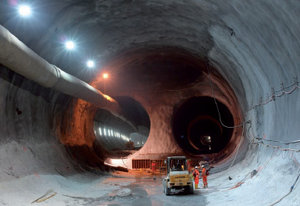

Conventional Tunnelling can be defined as the construction of underground openings of any shape with a cyclic construction process composed of the following steps:
- excavation, by using the drill and blast methods (explosives) or very basic mechanical excavators
- mucking
-
placement of the primary support elements such as:
- steel ribs or lattice girders
- soil or rock bolts
- sprayed or cast in situ concrete

Principles
Conventional Tunnelling is carried out in a cyclic execution process of repeated steps of excavation followed by the application of relevant primary support, both of which depend on existing ground conditions and ground behaviour. An experienced team of tunnel workers (miners), assisted by standard and/or special plant and equipment shall execute each individual cycle of tunnel construction.
The Conventional Tunnelling Method mainly using standard equipment and allowing access to the tunnel excavation face at almost any time is very flexible in situations or areas that require a change in the structural analysis or in the design and as a result of this also require changes in the support measures.
In fact, as opposed to TBM excavation, conventional tunneling allows a very flexible process where the following changes can be easily applied during construction:
- Increase or decrease of support
- Variation of ring closure time (delay between excavation and application of support)
- Introduction of primary support ring closure
- Variation of explosives charge
- Increased or decreased length of excavation
- Splitting of the excavation face according to geological conditions
- Ground treatment according to geological conditions
To know more:
ITA Endorsed paper